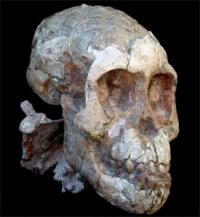 Meet the Dikika baby, a three-year old girl who lived 3.3 million years ago in the Awash Valley of Ethiopia, near where the 3.2 mil. year old hominin Lucy was discovered in 1974. Ethiopian scientist Zeresenay Alemseged, and his team from the Max Planck Institute for Evolutionary Anthropology in Leipzig, Germany, slowly removed this fossil from sandstone in the Afar Depression of Africa's Great Rift Valley. She is also a member of the species Australopithecus afarensis, the ancestor of our genus, Homo. The Dikika baby is the most complete ancient infant ever found.
Meet the Dikika baby, a three-year old girl who lived 3.3 million years ago in the Awash Valley of Ethiopia, near where the 3.2 mil. year old hominin Lucy was discovered in 1974. Ethiopian scientist Zeresenay Alemseged, and his team from the Max Planck Institute for Evolutionary Anthropology in Leipzig, Germany, slowly removed this fossil from sandstone in the Afar Depression of Africa's Great Rift Valley. She is also a member of the species Australopithecus afarensis, the ancestor of our genus, Homo. The Dikika baby is the most complete ancient infant ever found.In common with others of her species, the Dikika baby has a small brain size and a jutting ("prognathic") face. Models of her sharply resemble a chimp, and yet she is, like other members of Australopithecus afarensis, bipedal. Hominins can also be identified by their smooth brow and short canine teeth, which led Zeresenay to notice her skull jutting out of the stone. The fossil was in amazing shape, although embedded in sandstone, and took the team five years to excavate, so far.
Impressively, the Dikika baby has an early version of a hyoid bone, a bone which later evolved into the human voice box. She also has a human-like lower torso, including feet that cannot grasp like an ape. Hominins therefore had to depend more on their mothers than baby chimps do, perhaps giving human society its unique family structure. Lastly, she has a brain similar to that of a chimp, which likely would have grown as large as Lucy's. This implies that childhood was becoming a significant stage in life. In fact, the Dikika baby may have been alive during the origins of hominin childhood, a long period of dependency that allows us to grow our large brains, and become uniquely human.
No comments:
Post a Comment